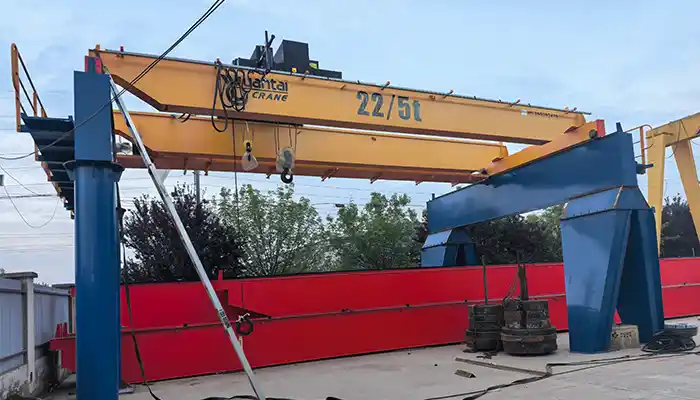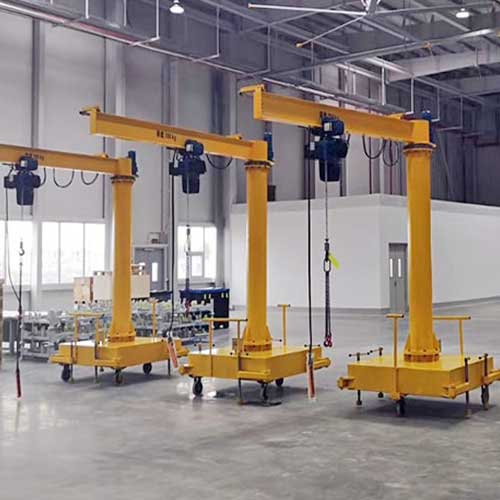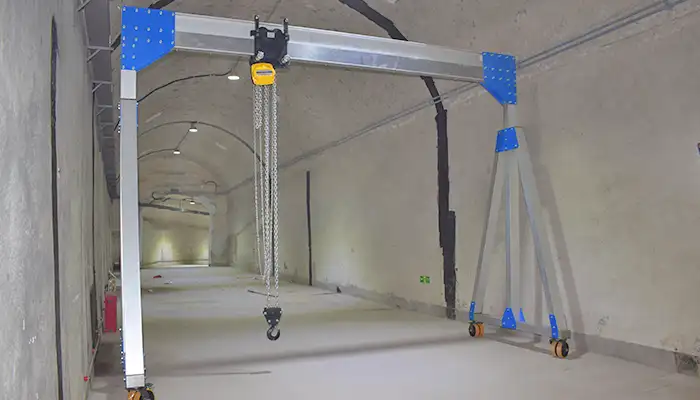Battery-Powered Mobile Jib Crane 500kg, 1000kg, 2000kg for Sale
Mobile jib cranes (500kg, 1000kg, 2000kg) electric battery-powered design for your lifting.Small jib crane on rollers for sale, cheap jib crane price.
Category: Jib Crane
Your Trusted Mobile Jib Crane Manufacturer & Supplier
Mobile Jib Crane 500kg, 1000kg, 2000kg for Sale, Electric Battery-Powered Design, Cheaper Small Jib Crane for Sale
Battery mobile jib cranes for sale in 500kg, 1000kg, and 2000kg capacities. Choose between electric or battery-powered models for versatile lifting.
Mobile Jib Cranes for Sale
Mobile jib cranes are incredibly handy pieces of equipment designed to lift and move loads with ease. Imagine a small crane on wheels that you can move around a workshop or warehouse, helping you lift items that are too heavy or awkward to handle manually. These cranes come in various capacities—500kg, 1000kg, and 2000kg—making them versatile tools for different lifting needs.
A mobile jib crane is essentially a crane mounted on a wheeled base that allows for easy movement around a workspace. The crane arm extends from a vertical mast, allowing it to reach over and lift objects. It's perfect for applications where you need flexibility in positioning your load, whether you're moving materials across a production line or retrieving items from a storage area. The ability to pivot and move the crane means you can tackle a variety of tasks without needing to reposition the entire unit.
Importance in Various Industries
These cranes are more than just convenient—they're crucial in many industries. In manufacturing, they streamline assembly lines and reduce manual handling, which can lead to quicker production times and fewer injuries. In warehouses and logistics, they help with the quick and efficient movement of goods, which can improve overall operational efficiency. Whether you're dealing with heavy machinery or just need to move materials from one place to another, mobile jib cranes make these tasks simpler and safer.
So, if you're considering adding one of these cranes to your operation, you're looking at a piece of equipment that not only gets the job done but does so with a level of flexibility and efficiency that can make a real difference in your daily operations.
Mobile Jib Crane Specifications
Capacity Options
500kg Mobile Jib Crane
Typical Applications
The 500kg mobile jib crane is ideal for lighter lifting tasks. It's commonly used in small workshops, light manufacturing, and maintenance areas. This crane can handle tasks like moving small machinery, components, or tools across a workbench or assembly line.
Load Handling Capacity
With a maximum load capacity of 500 kilograms, this crane is perfect for tasks that don't require heavy lifting but still need precision and mobility. It can easily manage the weight of smaller loads without strain, making it a reliable choice for lighter operations.

500kg mobile jib crane with electic battery powered roller travelling design, customized small jib crane on wheels or rollers with capacity up to 1 ton and 2 ton
1000kg Mobile Jib Crane
Typical Applications
The 1000kg model is a step up, suited for medium-duty applications. It's frequently used in larger workshops, small factories, and logistics operations where moderate lifting is required. This crane can handle medium-sized equipment, components, and materials with ease.
Load Handling Capacity
Boasting a capacity of 1000 kilograms, this crane is versatile enough to handle a range of moderate loads. It strikes a balance between strength and flexibility, making it suitable for tasks that exceed the lighter 500kg model but don't require the heft of larger cranes.
2000kg Mobile Jib Crane
Typical Applications
For heavier lifting needs, the 2000kg mobile jib crane is your go-to. It's used in heavier industrial settings, large workshops, and areas where substantial loads need to be moved frequently. This crane can handle heavier machinery, large components, and bulk materials with ease.
Load Handling Capacity
With a robust capacity of 2000 kilograms, this crane can tackle more demanding tasks. It's built to handle heavier loads without compromising performance, making it a dependable choice for environments where lifting larger or heavier items is a regular requirement.
Design and Features
Basic Design Considerations
Mobile jib cranes are designed with a balance between strength and mobility. They feature a crane arm mounted on a wheeled base, which allows for easy movement and positioning. The design needs to be robust enough to support various loads while remaining flexible for different applications.
Key Components
- Arm: The horizontal part of the crane that extends to lift and move loads. It's designed to reach out over the load area and has varying lengths depending on the model.
- Base: The sturdy foundation that supports the crane. For mobile versions, it's equipped with wheels or casters to facilitate movement.
- Mast: The vertical component that supports the arm and allows it to pivot. It must be strong enough to handle the stresses of lifting and moving loads.
Mobility Features
- Casters/Wheels: These are critical for the mobile crane's functionality, allowing for easy movement and positioning within a workspace. High-quality casters ensure smooth rolling and stability on various surfaces.
- Locking Mechanisms: Many mobile jib cranes come with locking features to secure the crane in place during operation. This prevents movement while the crane is in use, ensuring safety and precision.
These specifications and features, you can better select the mobile jib crane that fits your operational needs, ensuring efficiency and safety in your lifting tasks.
Application of Battery-Powered Mobile Jib Cranes
Electric Battery-Powered Mobile Jib Cranes
When it comes to mobile jib cranes, one of the key decisions buyers face is whether to opt for an electric or battery-powered model. Both types have their own set of advantages, and the right choice largely depends on how and where the crane will be used. Electric-powered cranes provide continuous, high-performance power, making them ideal for operations with reliable access to electricity. On the other hand, battery-powered models offer unmatched portability and the freedom to operate in areas where power outlets may be limited. Understanding the differences between these two options can help you select the crane that best fits your specific needs and work environment.

electric battery powered mobile jib crane on rollers for sale
Electric Mobile Jib Cranes
Power Requirements
Electric mobile jib cranes run on direct power supplied through an electrical connection. This means they need to be plugged into a power source or an extension cord. The power requirements vary depending on the crane's size and load capacity, so it's essential to ensure that your power source can handle the electrical load to avoid issues.
Advantages
One of the major benefits of electric mobile jib cranes is their continuous power supply. They can operate for long periods without needing to pause for recharging, making them ideal for high-demand environments where consistent performance is crucial. Electric models also tend to offer higher lifting capacities and more advanced features compared to battery-powered ones, providing better performance for demanding tasks.
Common Applications
Electric mobile jib cranes are often used in manufacturing facilities, assembly lines, and heavy-duty workshops. They're perfect for environments where a stable and reliable power source is available, and where frequent and extended use is expected. You'll find them in settings where heavy lifting and continuous operation are needed, such as in factories or large warehouses.
Battery-Powered Mobile Jib Cranes
Battery Life and Charging Considerations
Battery-powered mobile jib cranes use rechargeable batteries as their power source. Battery life can vary depending on the crane's usage, load, and type of battery. Regular charging is necessary to ensure that the crane remains operational. It's a good idea to have spare batteries or a charging station on hand to avoid downtime, especially in busy work environments.
Advantages
The key advantage of battery-powered mobile jib cranes is their portability. Without the need for a constant electrical connection, these cranes can be used in locations where power outlets are not readily available. They offer greater flexibility in terms of where they can be positioned and used. Additionally, battery-powered cranes are often quieter and produce no emissions, making them suitable for use in more sensitive environments like clean rooms or offices.
Common Applications
Battery-powered mobile jib cranes are ideal for settings where mobility and flexibility are important. They're commonly used in smaller workshops, service areas, and places where power outlets are scarce or non-existent. These cranes excel in environments that require less frequent, but flexible lifting operations, such as maintenance tasks, smaller assembly lines, or locations with limited access to power.
By understanding the differences between electric and battery-powered mobile jib cranes, you can choose the right type for your specific needs, balancing performance, convenience, and operational requirements.
Load Requirements
Assessing the Correct Capacity for Your Needs
When selecting a mobile jib crane, determining the correct load capacity is one of the most critical steps. You'll want to start by looking at the maximum weight of the items you lift regularly, but don't forget to consider potential future needs. It's easy to underestimate how much you might need to lift as your business expands or takes on new tasks, so always factor in a buffer for growth. For instance, if your current needs revolve around lighter loads, a 500kg crane may suffice, but if there's any chance you'll begin handling heavier equipment or components, a 1000kg or 2000kg model would offer more flexibility.
Another key point is that overloading a crane – even occasionally – isn't just risky but also harmful to the equipment. Constant overloading can wear out parts quickly, reduce performance, and pose serious safety hazards. It's better to invest in a higher capacity upfront than risk inefficient operation and safety breaches by overburdening your crane.
Impact of Load Capacity on Crane Selection
Load capacity does more than just dictate how much weight the crane can lift; it also influences the crane's design, structure, and cost. Cranes with higher capacities, like a 2000kg mobile jib crane, are designed for heavy-duty use and tend to be more robust, often with reinforced materials and larger components to withstand tougher jobs. These cranes generally offer superior durability and longer operational life, but they also require more space, have a larger footprint, and typically come at a higher price point.
On the flip side, a lower-capacity crane, such as a 500kg or 1000kg model, will be lighter and more compact, which can be advantageous in smaller work areas or for tasks that require frequent relocation. They are also more budget-friendly in terms of both initial investment and ongoing maintenance. However, the trade-off is that these cranes may not handle heavy-duty tasks as efficiently or safely. If you select a crane with a lower load capacity than needed, you could face limitations in your operations and potentially the need for expensive upgrades or replacements later on.
Balancing these factors—capacity, space, and cost—is essential for ensuring your mobile jib crane meets your current and future needs while staying within budget. By accurately assessing your load requirements, you can prevent costly mistakes, enhance safety, and increase operational efficiency.
Environment and Usage
Indoor vs. Outdoor Use
The environment where your mobile jib crane will be used plays a big role in choosing the right model. Indoor cranes don't usually need to withstand harsh weather conditions, so you can focus on factors like maneuverability and compact design. However, if the crane will primarily operate outdoors, it must be rugged enough to handle environmental challenges such as rain, dust, and temperature swings. Cranes built for outdoor use often feature corrosion-resistant materials, weatherproofing, and heavier-duty tires or wheels to ensure they can function well in less predictable conditions.
If you require a crane that can transition between indoor and outdoor tasks, it's wise to opt for a versatile model that can handle both environments. Look for features like durable construction, adaptable wheels, and protection against environmental wear and tear. This flexibility can save you from needing two separate cranes for different locations.
Factors Affecting Crane Performance
Several factors in your work environment can significantly affect a mobile jib crane's performance. One of the biggest considerations is the surface it will operate on. For instance, smooth, even floors make maneuvering easy, while rough or uneven surfaces can challenge a crane's stability and movement. In these cases, you'll need to ensure that the crane has the right type of wheels or casters to match the surface—larger, more rugged wheels for outdoor or rough terrain, and smaller, smoother casters for flat indoor surfaces.
Another crucial factor is space. A cluttered or tight workspace can make it difficult to safely operate the crane, particularly if the crane's arm needs room to swing or extend. Take measurements of your workspace and ensure that the crane you select has the mobility and range needed to maneuver efficiently within your available space. This will help avoid accidents or operational inefficiencies, especially in environments where space is tight or obstacles are present.
Maintenance and Support
Maintenance Requirements for Electric vs. Battery-Powered Models
Both electric and battery-powered mobile jib cranes have their own maintenance needs. Electric mobile jib cranes tend to require routine checks on their electrical systems, such as inspecting power connections, wiring, and motors to ensure everything functions smoothly. You'll also need to verify that there's no wear or corrosion on electrical components, especially if the crane operates in demanding environments.
For battery-powered models, maintenance revolves around the battery system itself. Regular charging and monitoring battery health are essential, as well as replacing batteries when they begin to lose efficiency. Additionally, it's a good idea to keep spare batteries on hand to avoid operational delays. While battery-powered cranes offer more portability, their performance is tied to proper battery maintenance, which should be a key part of your upkeep plan.
Availability of Spare Parts and Service Support
One of the most crucial considerations before purchasing any crane is ensuring the availability of spare parts and service support. If something breaks or wears out, quick access to parts can make the difference between a short repair time and extended downtime that disrupts your operations. Make sure to check if the manufacturer or supplier has a strong network for providing replacement parts and services. It's also worth looking into the company's reputation for customer support. A responsive service team can help troubleshoot problems, provide maintenance tips, and get your crane back up and running with minimal delays.
Cost and Budget
Price Range for Different Capacities
The price of mobile jib cranes can vary significantly based on their load capacity. A smaller 500kg crane will naturally be more affordable than a larger 2000kg model, but this difference in price reflects more than just load handling. Higher-capacity cranes are built with stronger materials, more robust components, and often come with enhanced features like longer reach or greater stability, all of which increase the cost. When budgeting, it's essential to align your spending with your operational needs—don't just look for the cheapest option. If your tasks require regular lifting of heavier loads, investing in a higher-capacity crane will pay off in terms of durability and safety.
Cost Differences Between Electric and Battery-Powered Models
The choice between an electric or battery-powered mobile jib crane can also affect your budget. Electric cranes tend to have a higher initial price tag due to their more complex power systems and often superior lifting capacities. Their continuous power supply also means they're generally more suited for long, uninterrupted operations. On the other hand, battery-powered cranes might have a lower upfront cost but could incur more expenses over time due to battery maintenance, recharging, and eventual battery replacement. Depending on your worksite setup—such as the availability of power outlets or the need for mobility—you'll need to weigh the immediate savings of battery-powered cranes against the potential long-term costs of maintaining them.
Long-Term Cost Considerations
When making your decision, don't just focus on the purchase price—think about the total cost of ownership over time. Electric cranes may have higher energy efficiency and lower maintenance costs, especially if they don't require frequent power system repairs. However, battery-powered cranes offer greater flexibility since they aren't tied to a power source, which can be a huge advantage in mobile or outdoor settings. That said, batteries will degrade over time, requiring replacements that can add to the overall expense. Maintenance costs, energy consumption, and component durability should all factor into your decision. By evaluating both the short-term and long-term financial impacts, you can make a more informed choice that suits your budget and operational needs.
Safety Considerations
Safety Features to Look For
When selecting a mobile jib crane, safety should be a top priority, especially when handling heavy loads. The right safety features can significantly reduce the risk of accidents and ensure a smoother operation. Here are some essential safety elements to consider:
Overload Protection
This feature prevents the crane from lifting more than its rated capacity, which is critical for avoiding equipment failure or dangerous accidents. Overload protection mechanisms typically include sensors or electronic systems that automatically halt lifting if the weight exceeds the crane's limits. Without this feature, the risk of tipping or component failure increases, jeopardizing both the operator and the equipment.
Stability Mechanisms
Ensuring the crane's stability during operation is crucial, particularly when moving across uneven surfaces or when handling heavier loads. Features like lockable casters or adjustable outriggers help stabilize the crane, preventing unwanted movement or tipping during operation. If the crane is frequently used in environments with varied terrain, opt for a model with enhanced stability features like wider bases or additional counterweights.
Emergency Stop Controls
In any workplace, emergencies can arise without warning. An easily accessible emergency stop button allows the operator to quickly shut down the crane in case of a malfunction, load instability, or any other hazardous situation. This feature should be positioned for quick access and clearly labeled so that it can be used in seconds if needed, which could be the difference between a close call and a serious accident.
Safety Warnings and Labels
Visible and clear safety labels are another critical aspect to consider. Cranes should have markings that specify the maximum load capacity, operational limits, and any other crucial safety information. Labels can help ensure that operators stay within safe operating parameters and can serve as a constant reminder of the crane's limitations. Additionally, warning decals in high-risk areas, like pinch points or moving parts, can prevent unnecessary injuries.
By prioritizing these safety features, you'll not only protect your team but also prolong the lifespan of your mobile jib crane, ensuring it operates efficiently and safely for years to come.
500kg mobile jib crane with electic battery powered roller travelling design
Best Practices for Safe Operation
To ensure the safe and efficient use of a mobile jib crane, it's crucial to follow established best practices. These guidelines protect operators, extend the crane's lifespan, and minimize downtime due to accidents or malfunctions. Here's a comprehensive look at key safety practices:
Inspect Before Use
Before every operation, perform a thorough inspection of the crane. Check for visible damage or wear on structural components like the jib arm, base, and casters. Also, examine the lifting mechanisms such as chains, hooks, or wires for any signs of damage or malfunction. For battery-powered cranes, verify the battery charge level and inspect the power connections. Early detection of small issues can prevent significant safety risks and ensure the crane operates smoothly.
Proper Load Handling
Always verify that the load you're lifting is within the crane's rated capacity. An overloaded crane can lose balance, increasing the risk of tipping or tipping over. Make sure the load is evenly distributed and use proper rigging techniques to prevent swaying or jerking during lifting. For particularly heavy or awkward loads, consider using additional lifting equipment or assistance to ensure a smooth and safe lift.
Secure the Crane
Position the crane on a stable, level surface and secure it in place before beginning operations. Lock the wheels or deploy stabilizing outriggers to prevent movement during the lift. This step is vital, especially on uneven surfaces or inclines, to maintain stability and prevent accidents. Securing the crane helps avoid unexpected shifts under load, which can lead to dangerous situations.
Avoid Overloading
Overloading is a major cause of crane accidents. Always adhere to the crane's maximum load capacity to avoid damage and safety hazards. If you're unsure of the load's weight, measure it before lifting to ensure it falls within safe limits. It's better to be cautious; overloading can strain the crane's components and compromise safety.
Train Users
Proper training is essential for all crane operators. Even if the crane appears easy to use, training ensures that operators understand the controls, safety protocols, and emergency procedures. Training should cover safe load handling practices and what to do in case of an emergency. Well-trained operators are less likely to misuse the crane and can respond effectively to unexpected situations.
By adhering to these best practices, you enhance the safety and efficiency of your mobile jib crane, protect users, and prolong the crane's service life.
Installation and Setup
Installation Requirements and Complexity
Setting up a mobile jib crane is typically a straightforward process, but there are several important factors to consider. Begin by selecting a stable, level surface for installation. This is crucial because an uneven surface can affect the crane's stability and performance. Most mobile jib cranes are designed for quick assembly, but you will usually need some basic tools like wrenches or screwdrivers to secure various parts such as the mast, arm, and base. Ensure the workspace is spacious enough to accommodate the crane's dimensions, including the turning radius of the jib arm, to avoid any constraints during operation. The weight of the crane also plays a role; heavier models might require additional assistance or lifting equipment to handle during assembly.
Setup Procedures and Initial Testing
Once the crane is assembled, it's crucial to follow a thorough setup procedure to ensure safe and efficient operation:
- Check Stability: Verify that the crane is securely positioned and stable. For models with wheels, lock them in place to prevent unintended movement. If the crane has stabilizers or outriggers, deploy them to enhance stability, especially if you're operating on an uneven surface.
- Test Movements: Check that the jib arm moves smoothly through its full range of motion. Ensure that the wheels or casters roll freely and do not get stuck. Smooth movement is essential for precise lifting and positioning.
- Load Testing: Conduct a test lift with a load that is well below the crane's maximum capacity. This step helps confirm that the crane's lifting mechanism works correctly and that the crane handles loads as expected. Avoid using the crane for its full capacity until you've confirmed its proper function during these tests.
- Review Controls: Familiarize yourself with the crane's controls, whether they are manual or electric. Test all buttons, switches, and levers to ensure they operate correctly. Properly functioning controls are vital for safe and efficient crane operation.
Performing these setup procedures and initial tests helps to identify and address any potential issues before the crane is used for heavier lifting tasks. This proactive approach can prevent operational problems and ensure a safer work environment.
Operation and Training
Training Requirements for Users
Proper training is essential for both safety and efficiency when operating a mobile jib crane. Ensure that all operators receive comprehensive instruction in several key areas:
- Controls and Functions: Operators should be familiar with all the crane's controls, including how to maneuver the jib arm, engage lifting mechanisms, and use safety features. Training should cover both manual and any powered controls, ensuring that operators can confidently and accurately perform their tasks.
- Safety Protocols: Training should emphasize safety guidelines to prevent accidents and injuries. This includes understanding the crane's load limits, proper use of safety features, emergency procedures, and general workplace safety rules. Operators should also be aware of potential hazards, such as overhead obstacles or unstable surfaces.
- Load Handling: Proper load handling techniques are crucial. Training should cover how to assess load weight, balance loads correctly, and use rigging equipment properly. Operators should be instructed on how to avoid common mistakes, like lifting loads unevenly or exceeding the crane's capacity.
Ease of Use and Operational Efficiency
When selecting a mobile jib crane, consider its ease of use, as this directly impacts operational efficiency:
- Intuitive Controls: Opt for a crane with user-friendly controls that are easy to understand and operate. Intuitive design reduces the learning curve and minimizes the risk of operational errors. Controls should be clearly labeled and positioned for comfortable access.
- Smooth Movement: A crane that moves smoothly and responds accurately enhances productivity. Features like fluid motion of the jib arm and reliable wheel or caster movement contribute to efficient operation. Smooth operation reduces the time spent on adjusting the crane and helps in completing tasks more quickly.
- Comfort and Integration: Ensure that the crane fits well into the operator's workflow and is comfortable to use. An ergonomic design and well-placed controls can make the crane easier to operate for extended periods, reducing operator fatigue and improving overall efficiency.
Choosing a crane that balances ease of use with robust training ensures that operators can work safely and effectively, maximizing both productivity and safety on the job.
Troubleshooting and Common Issues
Common Problems and Solutions
- Crane Not Moving Smoothly: If you notice that the crane is not moving smoothly, first check for obstructions or debris in the wheels or casters. Sometimes, dirt or small objects can impede movement. Additionally, ensure that the crane is set up on a level surface. An uneven or unstable base can cause operational issues. Adjust the crane's position or clean the wheels as needed.
- Load Won't Lift: If the crane is struggling to lift a load, start by verifying that the load is within the crane's rated capacity. Overloading the crane can prevent it from functioning correctly and might cause damage. Check the lifting mechanism for any visible signs of mechanical issues, such as worn-out parts or malfunctioning components. Properly assess the load distribution and ensure it's balanced.
- Electrical Issues (for Electric Models): For electric mobile jib cranes, electrical issues can arise. Inspect power connections and wiring for any signs of damage, loose connections, or disconnections. Ensure that the power source is functioning properly and that there are no issues with the power supply. If necessary, consult an electrician or technician to resolve complex electrical problems.
Tips for Troubleshooting Operational Issues
- Regular Maintenance: To prevent common issues, adhere to a regular maintenance schedule. Regularly inspect and clean the crane, check for wear and tear, and address any minor issues before they become major problems. Routine maintenance helps keep the crane in good working order and extends its lifespan.
- Consult the Manual: Always refer to the crane's user manual for specific troubleshooting tips and solutions. The manual typically includes a troubleshooting section that addresses common problems and provides step-by-step instructions for resolving them. It's a valuable resource for understanding your crane's specific needs and capabilities.
- Contact Support: If problems persist despite your best efforts, don't hesitate to contact the manufacturer or service provider for professional assistance. Experienced technicians can offer expert advice and repairs that may be beyond the scope of basic troubleshooting. Having access to responsive customer support can help minimize downtime and ensure that the crane remains operational.
By addressing these common issues and following these troubleshooting tips, you can maintain the smooth operation of your mobile jib crane, ensure safety, and resolve any operational challenges effectively.
Conclusion
Mobile jib cranes, available in capacities of 500kg, 1000kg, and 2000kg, offer versatile and efficient solutions for material handling across various industries. Whether electric or battery-powered, these cranes provide excellent mobility, ease of use, and performance. Buyers should consider load requirements, environmental factors, maintenance, and cost when choosing the right crane for their needs.
To choose the ideal mobile jib crane, start by assessing your load capacity needs and the environment in which the crane will operate. For indoor tasks or locations with easy access to power, an electric model may be the best choice due to its continuous power and reliability. If you need greater portability or work in areas without constant power, a battery-powered crane may be a more practical solution.
Think about long-term factors such as maintenance, energy consumption, and the availability of parts and service support. By carefully weighing your specific requirements, operational conditions, and budget, you can make a confident decision that enhances both safety and productivity in your work environment.
Main Projects
Related Products

22/5 Ton Overhead Crane Double Hook System: Robust double girder crane with 22-ton main and 5-ton auxiliary hooks for heavy lifting. Get double hook crane!
Free consultation to Confirm Parameters & Specifications and Get
Latest Crane Price & Crane Rate.
- Types of overhead cranes : _______?
- Optional: Overhead travelling crane, goliath gantry crane,Slewing jib crane, Single girder or double girder crane,small portable crane or kbk crane, etc.
- Capacity of overhead crane: _______?
- Optional: 0.25ton, 0.5 ton, 1 ton, 2 ton, 3ton, 5 ton, 10 ton,15ton, 20ton, 25 ton, 30ton,35ton, up to 550ton, etc.
- Crane span & lifting height : _______?
- Crane travelling length : _____?
- Control of overhead crane:_______?
- Optional: pendant/ remote/cabin control
- Voltage supply of overhead crane:_____?
- Eg,: 380V50/60HZ,3Phase or others,etc.
- Application/usage of crane:_______?
- Eg,: Steel mill, ,injection mold, cement,stone, concrete,granite, general manufacturing, etc.
Just leave a message via the contact form and our hoist and crane engineer will contact you with in 24working hours.
Get In Touch




